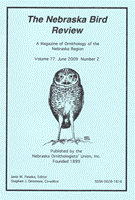Nebraska Ornithologists' Union

Nebraska Bird Review
Date of this Version
3-2024
Document Type
Article
Citation
Nebraska Bird Review, volume 92, number 1, March 2024, pp. 29–45
Abstract
With the resurrection of the Kearney count, twenty CBCs [Christmas Bird Counts] were run in the 2023–2024 season. This is four more than last year and one more than the previous high number of nineteen from 2021. Although the Crawford, Harrison, and Scottsbluff counts were postponed because of snow, the weather on count days was mild with an average high of 43°F and an average low of 27°F, resulting in mostly open water. Rain and mud eliminated access to several normally productive areas of the Harlan County count which still produced the highest number of species (94). Lake McConaughy produced 89 species with only 4 observers. The total number of species for all counts was 146, which is the third highest. There were 149 species in 2010 and 147 in 2015. However, the total number of individuals (282,280) was fairly typical. There were 957 total party hours.
Twelve species, including Bald Eagle, were found in all circles. Thirty-one species were found in just one circle with nine of those being a single bird. Thirty species set or tied high counts. New to Nebraska CBCs were the two Whooping Cranes found along the Platte River at Grand Island.
. . .
I don’t feel that I’m going out on a limb when I say that those of us who participate in CBCs enjoy coming up with high numbers of different species and individuals of a particular species. We especially enjoy finding those birds that are out of place at this time of the year. This year’s counts certainly didn’t disappoint us. Who would have guessed that Sandhill Cranes would be the fifth most numerous species?
But perhaps looking at Christmas counts as citizen science rather than a competition to see who can find the best birds, these results should be a bit concerning. While having more counts and observers undoubtedly can produce higher count totals, this year’s results were largely affected by the unusually mild weather we all enjoyed during December and the first week and half of January. Unfortunately, this was followed by a week of bitter cold and deep snow. It is likely that many of the tardy birds which we were happy to find on a CBC perished at this time. Moreover, this should be further proof of a changing climate. Something is definitely amiss when this season produced only two more Purple Finches than Whooping Cranes.
Included in
Ornithology Commons, Population Biology Commons, Poultry or Avian Science Commons, Zoology Commons


Comments
Published by the Nebraska Ornithologists’ Union, Inc.